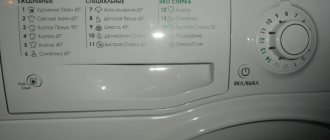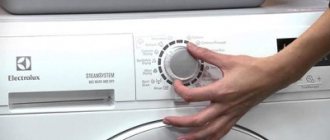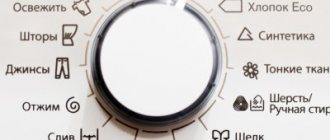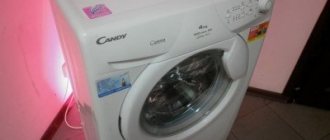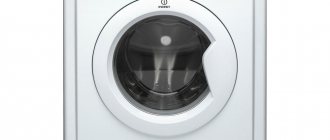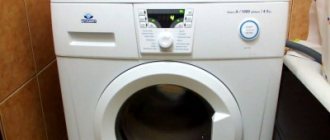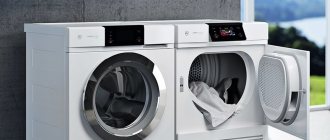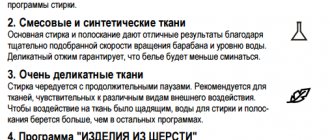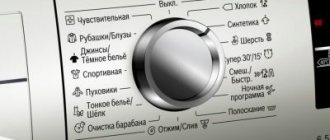A semi-automatic washing machine is in demand no less than automatic models, since not all parts of the country have the conditions for their connection and normal functioning. Semi-automatic units are often found in rural areas and in holiday villages where there are difficulties with water supply or there is no water supply at all. And in a small apartment with a small bathroom, such a device is a good help in doing laundry, the main thing is to use the semi-automatic washing machine correctly.
Types of semi-automatic washing machines
These units are divided into two types according to the number of tanks:
- with one;
- with two.
It is necessary to learn in more detail the characteristics of each category of semi-automatic washing machines to make it easier to understand the operating principle of such a device.
- Single tank machine
These models are the simplest semblance of automatic washing machines, since the processes of washing and spinning clothes are carried out in one container. However, you will have to fill and drain water, set the duration of the washing, rinsing and spinning process manually. Unlike two-tank models, they do not require transferring wet laundry from the first tank to the second. But semi-automatic washing machines of this type are quite rare, since models with two containers are more often produced.
- Double tank machine
These are more popular types of semi-automatic machines, created on the basis of two containers - the main one for washing, and the additional one for drying clothes. There is no automation here; there are only mechanical wash and spin timers that allow you to set the required operating time.
You need to add hot water manually, but if it is only cold, you need to heat it up first. To spin, the laundry must be transferred to an additional tank with a built-in centrifuge.
You need to rinse laundry from powder and soap in a separate container, since hot water poured into the main tank can be used for several wash cycles (if it is not dirty). If you wish, you can rinse things in the tank where the washing takes place, but you will have to constantly pour out and add water.
When choosing which washing machine is better to choose - automatic or semi-automatic, it is worth considering that the unit of the first option cannot be installed everywhere. For example, in a country house or village there is often no sewerage system or normal water supply, so the operation of such a device will be impossible. Also, you need to install an expensive automatic washing machine only in suitable climatic conditions, which cannot be said about an unheated dacha. And having familiarized yourself with the varieties of semi-automatic washing machines, it becomes clear that this unit can not only wash, but also perform additional functions.
Key Features
- First, pay attention to the washing class. It goes from A (best) to G (worst). The higher the washing class, the better the machine will cope with dirt.
- Secondly, pay attention to the energy class . Models marked A are the most economical, but expensive. Cars of classes B and C are more budget-friendly.
- Thirdly, pay attention to the maximum permissible weight of loaded laundry . For a dacha, a machine with a load of 3-4 kg is enough; for the home, it is better to choose more serious devices.
- Fourthly, pay attention to the material used to make the washing machine tank . Plastic and stainless steel can be used for this. The second option is more common and durable, the first is more practical and budget-friendly.
- Fifthly, pay attention to the cost indicator. For many buyers, this moment is decisive. Actually, prices for the most budget semi-automatic washing machines start at 3.5-4 thousand rubles and then increase as the functional and quality components increase.
Why won't the washing machine door open? How to open it manually?
What do Indesit washing machine error codes mean? Find out in this article.
Why doesn't the washing machine turn on? https://vannaja-komnata.com/tehnika/stiralnaya-mashina/ne-vklyuchaetsya-prichiny.html
Advantages and disadvantages of using semi-automatic machines
When choosing a semi-automatic washing machine, you need to consider the pros and cons of this unit. The main advantages include:
- compact dimensions - the washing machine can easily fit in any, even very small, room;
- light weight - a semi-automatic washing machine can be easily moved from one place to another in the house and taken with you in the car (for example, to take it to the country);
- efficiency - unlike its fully automatic counterpart, such a unit consumes less electricity and water;
- vertical loading - even when the washing process is running, items can be added to the tank;
- ease of operation and reliability - there is no need to use special detergents that soften hard water and prevent the appearance of scale, while an automatic washing machine will quickly break down without them;
- you can wash and dry clothes at the same time - this is important for two-tank models;
- no sewerage or centralized water supply is required - before starting the wash, you need to fill the tank with water, and at the end, drain it to a suitable place;
- you can use any powder, even those intended for hand washing;
- You can wash white clothes first, and then, without changing the water, dark clothes;
- Semi-automatic machines do not have a heater and electronics, so such units break down much less often, and repairs will be cheaper than with automatic machines;
- The affordable price of a semi-automatic washing machine allows anyone to purchase it.
The main disadvantages of semi-automatic models include:
- lower power than automatic machines, so it is not always possible to completely remove dirt from things;
- powerful semi-automatic models are similar in price to the cost of automatic washing machines;
- the harder the water, the worse things are washed and to avoid this, it is recommended to install special filters, which will significantly affect the cost of the unit;
- limited actions - semi-automatic washing machines do not have as many programs as an automatic machine;
- in devices without a drying function, you can only wash, and you will have to wring out things manually;
- washing in a semi-automatic machine must be constantly monitored, since it is necessary to regularly change the water, rinse and wring out things;
- when the hot water is turned off, washing causes additional difficulties;
- Since semi-automatic washing machines have vertical loading, nothing can be stored on top of them, which is not very convenient in a small room.
Having compared all the pros and cons, it is easy to understand that a semi-automatic machine is an indispensable thing if it is not possible to install an automatic washing machine.
pros
- This machine comes in handy when there is no centralized water supply. That is why a semi-automatic machine is often chosen for installation in a country house or rural house.
- The semi-automatic machine saves water and electricity.
- This model of washing machine is very simple to use, and it does a good job of quickly washing clothes.
- For washing in such a machine, you can use any powder, even for hand washing.
- Since semi-automatic machines do not have complex electronics and also do not have a heater, such machines break down less often, and their repair costs much less than repairing an automatic model.
- You can save water and powder in a semi-automatic machine if you wash white clothes in such a machine, and then, without draining the water, wash dark clothes in it.
- Linen can be added to or removed from the machine at any time during the wash cycle.
- The cost of semi-automatic machines is low, so such equipment is available to any user.
Semi-automatic functions
Before using a semi-automatic washing machine, you need to find out about the additional functions that these units are equipped with:
- Spin
Most semi-automatic washing machines are equipped with a spin function. In two-tank models, it is carried out in a centrifuge installed in one of them. If the unit is single-tank, then drying is either absent or performed in the same container.
- Rinsing
To rinse clothes in a semi-automatic machine, you need to repeatedly pour water into the tank. To do this, take things out of the main tank after washing, drain the dirty water, fill the machine with clean water, put clean clothes back in there and start the rinse mode.
- Drain
In most semi-automatic washing units, water is drained manually; for this purpose, a drain hole is provided at the bottom of the tank, onto which a hose can be attached if necessary. If there is a drain pump in a semi-automatic device, the cost of the unit will increase significantly.
These are the main functions of a semi-automatic washing machine, allowing you to make the washing process more convenient. And if you can rinse clothes not only in the machine, but in a basin or bathtub, then the presence of a spin cycle significantly facilitates the most difficult part of the process, especially when you need to squeeze out large items.
Minuses
- To rinse a semi-automatic machine, you need to refill water, which increases its consumption.
- In models without spinning, you can only wash clothes, and you will have to spin things manually.
- The efficiency of washing in semi-automatic machines is low.
- It is impossible to leave a semi-automatic machine for a long time, since it is necessary to remove the laundry, drain the water and carry out other manipulations.
- During hot water outages, using a semi-automatic machine causes additional trouble.
- Since the loading in semi-automatic machines is vertical, nothing can be stored on top of such devices, which is a very noticeable disadvantage for a tiny bathroom.
Depending on the principle of operation, a semi-automatic machine can be:
Activator models are more common due to their efficiency and reliability. At the bottom of their tank there is a disk that begins to rotate under the influence of the engine. Drum models have a perforated drum.
Also, these machines differ in the number of tanks. There can be only one tank in a semi-automatic machine, and then both washing and rinsing are carried out in it, and the laundry is wrung out manually. There are also machines with two tanks - in one of them the clothes are washed, and in the second they are wrung out.
Another difference between different semi-automatic machines is the presence of reverse. In models that have this function, the laundry spins in both directions, but in machines without reverse, the clothes rotate only in one direction during washing.
The cost of semi-automatic machines, when compared with the prices of most automatic machines, is quite low. You can buy them for 2-5 thousand rubles, and used equipment costs even less.
How to use a semi-automatic machine
The washing process in a semi-automatic machine is quite simple. To do this you need to do the following:
- sort the laundry into several groups - white, colored, cotton, wool, delicate, heavily soiled, etc.;
- if necessary, some items can be pre-washed or soaked (this can be done the day before);
- pour as much hot water into the machine as is required to completely fill the container, including the laundry;
- if there is no hot water, then it must first be heated;
- pour in the amount of washing powder recommended based on the weight of the laundry and degree of soiling;
- load things into the tank and connect the device to the power supply;
- set the washing time using a mechanical timer;
- at the end of the process, you need to take out the laundry, drain the water and fill it with clean water, and then rinse the clothes in the machine (if there is such a function), basin or bathtub;
- after rinsing the laundry, you need to spin it out - in a two-tank machine with a centrifuge, things are immediately transferred there and the spin cycle starts;
- if there is one tank, first all the laundry is rinsed (if there was a lot of washing and the process was started more than once), and then spun in a centrifuge;
- At the end of the spin cycle, the laundry should be hung out to dry.
To facilitate and speed up the process of washing a large number of items in a model with two tanks, you first need to put in white or lightly soiled laundry, and then, if the water is still fairly clean, you can wash a new portion. Rinsing the laundry can be done in a basin, bath or centrifuge while a new wash is in progress, and then spin.
The washing process ends by disconnecting the unit from the power supply. After this, the water is drained from the semi-automatic washing machine, the tanks are rinsed and wiped dry.
Installation Features
There are no significant recommendations for installing a semi-automatic washing machine: it does not require connections to water supply and sewerage, which minimizes the duration and complexity of installation work.
There is only one important note: during spinning, the body of the product vibrates quite strongly. To prevent the machine from “jumping away”, place it on the most flat surface possible. If possible, additionally purchase a special anti-vibration floor panel.
In addition, try to install the machine in a room with a normal level of humidity (it will last longer) and at a minimum distance from the water source (it will simply be more convenient to do laundry).
Semi-automatic devices are less sensitive to power surges, which allows them to be connected not only to simple stationary sockets, but also to country generators.
Reviews
Owners of semi-automatic machines are satisfied with their purchase if it fully meets their requirements. Positive reviews can be heard from people who purchased the device for use in the country or in a private house without running water. They like the short wash cycle, low weight and low cost of semi-automatic machines.
The advantages of semi-automatic washing machines and positive reviews about economy-class washing equipment are presented in a short but informative report published on the Novosti 24 channel:
A semi-automatic washing machine is in demand no less than automatic models, since not all parts of the country have the conditions for their connection and normal functioning. Semi-automatic units are often found in rural areas and in holiday villages where there are difficulties with water supply or there is no water supply at all. And in a small apartment with a small bathroom, such a device is a good help in doing laundry, the main thing is to use the semi-automatic washing machine correctly.
Are there any difficulties with repairs?
Due to the simplicity of their design, semi-automatic machines rarely break down. They may have the following problems:
- The engine does not turn on when you change modes. This situation may be associated with failure of the relay, capacitor, brushes, transformer or other parts. Having found a faulty part, it is repaired or replaced with a new one. Sometimes the cause of the malfunction is a broken wire, to identify which the electrical circuit is checked.
- The spin does not start, although the motor is running. The reason may be that the machine is overloaded with laundry or there is too much water. If this is the case, some items should be removed from the tank and excess water removed. You should also check the centrifuge brake.
- The rotor does not start to rotate, although the engine is functioning normally. This happens due to wear of the diaphragm bushings (they will have to be replaced) or unevenly laid out laundry.
- Water begins to flow out from under the machine. Such a breakdown can be caused by damage to the tank, loosening of the rubber cuff, damage to the drain valve, or a malfunction of the drain pump.
- The centrifuge does not start, although the engine is working. The cause may be a slipped drive belt.
- The engine is not running. The problem may be with the electric motor itself or with its power cable. If the part cannot be repaired, you should replace the engine with a functioning one.
- Water from the tank is poured into the centrifuge. This situation is caused by a clog in the bypass valve. After disconnecting the device from the network and removing water from it, the valve is cleaned, and then the machine is restarted.
Review of popular models
One of the popular oversized semi-automatic machines of domestic production. Its advantages are affordable price, good functionality and compact size. Among the disadvantages are small capacity, low wash class, few functions, outdated design, and lack of spin in some models.
Assol
Quite a popular machine from a domestic manufacturer, in which you can wash up to 5 kg of laundry, and also spin up to 3.5 kg of washed clothes in a centrifuge. Such a device is controlled mechanically.
Eureka
The main difference between such a semi-automatic machine is the mechanism that switches the operating cycles step by step. In addition to the normal and gentle wash mode, this machine has four rinse modes. This machine can hold up to 3 kg of clothes, so it has a fairly compact size. In addition, this model has a drain pump.
Saturn
Semi-automatic devices from this manufacturer are represented by a large assortment. They are economical and can be installed anywhere. One of the most popular models of Saturn machines has a depth of 36 cm.
Zanussi FCS 825 C
Italian semi-automatic machine in which you can wash delicate fabrics and wool. It can load up to 3 kg of laundry. Using such a device is very simple, but this machine is relatively expensive.
UNIT-210
Austrian semi-automatic machine with normal and delicate washing and rinsing modes. The device holds 3.5 kg of clothes and has an affordable price. However, in such a machine you cannot wash in too hot water (more than +55ºС).
User manual
The stages of using a semi-automatic machine will be as follows:
- Heating water to the desired temperature (usually +40ºС). In some models, water is heated in the device.
- Pour warm water into the tank, add washing powder to it and load the laundry.
- Setting the washing time and selecting a program (some machines have a delicate mode in addition to the standard one).
- After a short wash, remove the laundry from the machine and drain the dirty water.
- Fill the machine with clean water and load laundry for rinsing.
- Spin clean laundry in a separate tank. In some machines, the laundry is wrung out in the same tank, but there are also models without spinning, in which you have to wring out the clothes with your hands after washing.
- Draining water from the machine.
